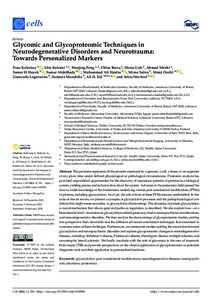Glycomic and Glycoproteomic Techniques in Neurodegenerative Disorders and Neurotrauma: Towards Personalized Markers
Kobeissy Firas; Kobaisi Abir; Peng Wenjing; Barsa Chloe; Goli Mona; Sibahi Ahmad; El Hayek Samer; Abdelhady Samar; Ali Haidar Muhammad; Sabra Mirna; Oresic Matej; Logroscino Giancarlo; Mondello Stefania; Eid; Ali H.Y; Mechref Yehia
Glycomic and Glycoproteomic Techniques in Neurodegenerative Disorders and Neurotrauma: Towards Personalized Markers
Kobeissy Firas
Kobaisi Abir
Peng Wenjing
Barsa Chloe
Goli Mona
Sibahi Ahmad
El Hayek Samer
Abdelhady Samar
Ali Haidar Muhammad
Sabra Mirna
Oresic Matej
Logroscino Giancarlo
Mondello Stefania
Eid
Ali H.Y
Mechref Yehia
MDPI
Julkaisun pysyvä osoite on:
https://urn.fi/URN:NBN:fi-fe2022081153864
https://urn.fi/URN:NBN:fi-fe2022081153864
Tiivistelmä
The proteome represents all the proteins expressed by a genome, a cell, a tissue, or an organism at any given time under defined physiological or pathological circumstances. Proteomic analysis has provided unparalleled opportunities for the discovery of expression patterns of proteins in a biological system, yielding precise and inclusive data about the system. Advances in the proteomics field opened the door to wider knowledge of the mechanisms underlying various post-translational modifications (PTMs) of proteins, including glycosylation. As of yet, the role of most of these PTMs remains unidentified. In this state-of-the-art review, we present a synopsis of glycosylation processes and the pathophysiological conditions that might ensue secondary to glycosylation shortcomings. The dynamics of protein glycosylation, a crucial mechanism that allows gene and pathway regulation, is described. We also explain how-at a biomolecular level-mutations in glycosylation-related genes may lead to neuropsychiatric manifestations and neurodegenerative disorders. We then analyze the shortcomings of glycoproteomic studies, putting into perspective their downfalls and the different advanced enrichment techniques that emanated to overcome some of these challenges. Furthermore, we summarize studies tackling the association between glycosylation and neuropsychiatric disorders and explore glycoproteomic changes in neurodegenerative diseases, including Alzheimer's disease, Parkinson's disease, Huntington disease, multiple sclerosis, and amyotrophic lateral sclerosis. We finally conclude with the role of glycomics in the area of traumatic brain injury (TBI) and provide perspectives on the clinical application of glycoproteomics as potential diagnostic tools and their application in personalized medicine.
Kokoelmat
- Rinnakkaistallenteet [27094]
